The Combined Effect of Glass Fiber Mesh and Steel Fiber on Two-Layered Preplaced Aggregate Concrete against Drop Weight Impact
Abstract
:1. Introduction
2. Materials and Methods
2.1. Base Materials
- Ordinary Portland Cement was utilized in this investigation as per the specifications outlined in Indian Standard IS: 12269–1987 [28]. Its specific gravity was 3.14 and had a specific surface area of 318 kg/m2.
- As per the requirements of the standard IS: 383–2016 [29], the fine aggregate was obtained from a natural river locally. It had a specific gravity of 2.65 and a fineness modulus of 2.41. Additionally, a unique grout mix in accordance with ASTM C939/C939M-16a [30] was confirmed by using the size of fine aggregate particles less than 2.36 mm. After that, a great gravity flow was accomplished, which resulted in the voids inside the skeletal aggregate being effectively filled.
- The dimension of the granite gravel that was employed for the coarse aggregate was 12.5 mm in size. The coarse aggregate had a bulk density of 1700 kg/m3, water absorption value of 0.56% and specific gravity of 2.69.
- A superplasticizer (Tec Mix 640) was utilized to enhance the grout flowability and meet the efflux time requirements. The used superplasticizer had a pH value of 7–8. The two dosages of selected superplasticizers were 0.4% and 0.6% (by cement weight) for the non-fibrous and fibrous specimens, respectively. PAFC is the fibrous mixture, and a higher superplasticizer dosage is required to make the grout flow under gravity. However, more flowable grout is required to fill the voids between the fibers and aggregates in a fibrous mixture. Hence, the superplasticizer dosage is enhanced in PAFC
- Hooked-end steel fiber, which has a 30 m length and 0.5 mm diameter, was employed in the concrete at a 3% dose. Figure 1 shows the steel fiber used and its tensile strength was 1400 MPa.
- Grids of two-way glass fiber reinforcement spaced at 5 mm intervals, 2 mm thickness and weighing 125 g/m2 per unit area were used in this study. The tensile strength of GFM was 25 KN/m. The GFM roll was sourced from Amazon India, and was cut for a circular shape of different diameters, as shown in Figure 2. The ratios of reinforcement surface to total sample surface were 0.33, 0.5, 0.67, 0.83 and 1.0.
2.2. Mixing Combination and Specimens Id
2.3. Preparation of Specimens
3. Testing Setup
4. Results and Discussions
4.1. Strength of PAFC under Compression
4.2. Results and Discussion of Impact Strength
4.3. Impact Ductility
4.4. Failure Pattern
4.5. Fiber Oreintation
4.6. Failure Mechanism
5. Conclusions
- The addition of a 3% dosage of steel fiber in PAFC revealed a compressive strength that was improved by 67.05% compared to non-fibrous specimens. The capability of evenly dispersed steel fibers to inhibit macro-crack expansions is frequently the primary reason for an inherent improvement in compressive strength. The PAFC casting technique eradicates the workability issues and fiber clustering due to the higher fiber content (more than 2%), since fibers and aggregates are pre-packed into the mold followed by grouting.
- Duplicating the number of intermediate GFMs from two to four increased the retained E1 and E2 of plain and fibrous mixtures. The percentage development in the impact energy due to this duplication was independent of the GFM ratio of reinforcement surface (diameter), while it was higher at failure stage (E2) compared to cracking stage (E1). As the main function of GFM is to arrest cracks from propagating across the contact area between the two specimen’s layers, its main function starts after cracking, which explains the higher developments in E2 compared to E1. For instance, the percentage developments in E1 of plain mixtures were in the range of 5.8 to 12.5%, while those of E2 ranged from 12.5 to 31.6%.
- GFM ratio of reinforcement surface (diameter) has a noticeable effect on the recorded impact energies, where decreasing the GFM ratio of reinforcement surface from the full intermediate contact area (150 mm diameter) decreased both E1 and E2, where the percentage improvement in E1 and E2 was increased with the increase of GFM ratio of reinforcement surface from 0.33 up to 150 mm. Due to the role of GFM in the specimens, this effect was also more pronounced at the failure stage than at the cracking stage, where the percentage developments (compared to reference specimens without GFM) in E1 of plain mixtures ranged from 36.4 to 81.8%, while the corresponding developments in E2 were in the range of 58.3 to 266.7%.
- Steel fibers are significantly superior to GFM in enhancing the impact performance. Comparing the impact energies of the fibrous specimens incorporating 3% SF with their corresponding plain (0% SF) specimens, significant improvements of 210 to 409% were recorded for E1, while great jumps of 1032 to 3108% were recorded for E2. These percentage improvements were much higher than those obtained by utilizing the GFM, which is attributed to the mechanisms of each mesh being a crack arresting material, where SFs are distributed across the whole volume in different angles composing a multi-directional discrete reinforcing matrix, while GFM provides a localized shield over only the contact area between the two layers of the specimen.
- Because the effect of GFM number, GFM ratio of reinforcement surface and SF are higher at the failure stage (E2) than at the cracking stage (E1), the ductility index (DI) increased due to their increase. As the effect of SF was superior to that of GFM, DI records of fibrous specimens were much higher than those of plain specimens. The ductility indices of the plain specimens were in the range of 1.1 to 2.2, while those of fibrous specimens ranged from 6.9 to 8.0. The percentage developments in DI due to increasing the number of layers and the ratio of reinforcement surface of GFM was much higher for plain specimens than for fibrous specimens due to the high DI records of fibrous specimens. Increasing the ratio of reinforcement surface of GFM improved DI of plain mixtures by 16.1 to 101.7%, while this improvement was 2.6 to 16.8% for fibrous mixtures. Similarly, duplicating the number of GFMs increased DI of plain mixtures by 4.8 to 23.4% and DI of fibrous mixtures by 0.9 to 5.2%, while the percentage developments in DI due to the incorporation of 3% of SF were in the range of 265 to 530%.
- The impact resistance was much lower in GFM-based non-fibrous specimens, irrespective of GFM layers. These specimens failed as soon as a fracture emerged, revealing their brittleness. Fibrous specimens with GFM have distinct impact strength capabilities that were significantly boosted by including fibers indicating ductile failure. Moreover, the layers of GFM in PAFC function as a barrier, prevent quick crack propagation and lengthen the duration of the failure with a more significant impact energy absorption capacity.
- Although the PAFC poses an excellent impact strength and there are some limitations, including: the dosage of steel fiber in PAFC is restricted to 6%; the number of GFM layers is restricted to four to avoid the shearing effect of PAFC under impact loading.
Author Contributions
Funding
Institutional Review Board Statement
Informed Consent Statement
Data Availability Statement
Acknowledgments
Conflicts of Interest
References
- Smirnova, O.M. Low-Clinker Cements with Low Water Demand. J. Mater. Civ. Eng. 2020, 32, 06020008. [Google Scholar] [CrossRef]
- Smirnova, O.M.; Potyomkin, D.A. Influence of ground granulated blast furnace slag properties on the superplasticizers effect. Int. J. Civ. Eng. Technol. 2018, 9, 874–880. [Google Scholar]
- Smirnova, O.; Kazanskaya, L.; Koplík, J.; Tan, H.; Gu, X. Concrete based on clinker-free cement: Selecting the functional unit for environmental assessment. Sustainability 2021, 13, 135. [Google Scholar] [CrossRef]
- Anas, S.M.; Alam, M.; Umair, M. Experimental and numerical investigations on performance of reinforced concrete slabs under explosive-induced air-blast loading: A state-of-the-art review. Structures 2021, 31, 428–461. [Google Scholar] [CrossRef]
- Nehdi, M.L.; Najjar, M.F.; Soliman, A.M.; Azabi, T.M. Novel steel fibre-reinforced preplaced aggregate concrete with superior mechanical performance. Cem. Concr. Compos. 2017, 82, 242–251. [Google Scholar] [CrossRef]
- Vatin, N.I.; Murali, G.; Abid, S.R.; Garcez de Azevedo, A.R.; Tayeh, B.A.; Dixit, S. Enhancing the Impact Strength of Prepacked Aggregate Fibrous Concrete Using Asphalt-Coated Aggregates. Materials 2022, 15, 2598. [Google Scholar] [CrossRef]
- ACI Committee 304. Guide for the Use of Preplaced Aggregate Concrete for Structural and Mass Concrete Applications. ACI Mater. J. 1992, 88, 650–668. [Google Scholar] [CrossRef]
- Manohar, S.N. The production and application of Colcrete. Indian Concr. J. 1967, 41, 262–275. [Google Scholar]
- Najjar, M.F.; Soliman, A.M.; Nehdi, M.L. Critical overview of two-stage concrete: Properties and applications. Constr. Build. Mater. 2014, 62, 47–58. [Google Scholar] [CrossRef]
- Awal, A.S.M. Manufacture and Properties of Prepacked Aggregate Concrete. Master’s Thesis, University of Melbourne, Melbourne, Australia, 1984. [Google Scholar]
- Abdelgader, H.S. Effect of the quantity of sand on the compressive strength of two-stage concrete. Mag. Concr. Res. 1996, 48, 353–360. [Google Scholar] [CrossRef]
- Coo, M.; Pheeraphan, T. Effect of sand, fly ash, and coarse aggregate gradation on preplaced aggregate concrete studied through factorial design. Constr. Build. Mater. 2015, 93, 812–821. [Google Scholar] [CrossRef]
- Holschemacher, K.; Mueller, T.; Ribakov, Y. Effect of steel fibres on mechanical properties of high-strength concrete. Mater. Des. 2010, 31, 2604–2615. [Google Scholar] [CrossRef]
- Li, P.P.; Cao, Y.Y.Y.; Sluijsmans, M.J.C.; Brouwers, H.J.H.; Yu, Q. Synergistic effect of steel fibres and coarse aggregates on impact properties of ultra-high performance fibre reinforced concrete. Cem. Concr. Compos. 2021, 115, 103866. [Google Scholar] [CrossRef]
- Liu, J.; Wu, C.; Liu, Z.; Li, J.; Xu, S.; Liu, K.; Su, Y.; Chen, G. Investigations on the response of ceramic ball aggregated and steel fibre reinforced geopolymer-based ultra-high performance concrete (G-UHPC) to projectile penetration. Compos. Struct. 2021, 255, 112983. [Google Scholar] [CrossRef]
- Mohamed, N.; Soliman, A.M.; Nehdi, M.L. Full-scale pipes using dry-cast steel fibre-reinforced concrete. Constr. Build. Mater. 2014, 72, 411–422. [Google Scholar] [CrossRef]
- Şahin, Y.; Köksal, F. The influences of matrix and steel fibre tensile strengths on the fracture energy of high-strength concrete. Constr. Build. Mater. 2011, 25, 1801–1806. [Google Scholar] [CrossRef]
- Lee, J.-H.; Yoo, D.-Y.; Yoon, Y.-S. Mechanical behaviour of concrete with amorphous metallic and steel fibres. Mag. Concr. Res. 2016, 68, 1253–1264. [Google Scholar] [CrossRef]
- Yang, K.H. Tests on concrete reinforced with hybrid or monolithic steel and polyvinyl alcohol fibers. ACI Mater. J. 2011, 108, 664–672. [Google Scholar] [CrossRef]
- Caetano, H.; Rodrigues, J.P.C.; Pimienta, P. Flexural strength at high temperatures of a high strength steel and polypropylene fibre concrete. Constr. Build. Mater. 2019, 227, 116721. [Google Scholar] [CrossRef]
- ACI Committee 544. Report on Fibre Reinforced Concrete; American Concrete Institute: Farmingtion Hills, MI, USA, 2002. [Google Scholar]
- Mohammadhosseini, H.; Tahir, M.M.; Alaskar, A.; Alabduljabbar, H.; Alyousef, R. Enhancement of strength and transport properties of a novel preplaced aggregate fiber reinforced concrete by adding waste polypropylene carpet fibers. J. Build. Eng. 2020, 27, 101003. [Google Scholar] [CrossRef]
- Prasad, N.; Murali, G. Exploring the impact performance of functionally-graded preplaced aggregate concrete incorporating steel and polypropylene fibres. J. Build. Eng. 2021, 35, 102077. [Google Scholar] [CrossRef]
- Murali, G.; Ramprasad, K. A feasibility of enhancing the impact strength of novel layered two stage fibrous concrete slabs. Eng. Struct. 2018, 175, 41–49. [Google Scholar] [CrossRef]
- Rithanyaa, R.; Murali, G.; Salaimanimagudam, M.P.; Fediuk, R.; Abdelgader, H.S.; Siva, A. Impact response of novel layered two stage fibrous composite slabs with different support type. In Structures; Elsevier: Amsterdam, The Netherlands, 2021; Volume 29, pp. 1–13. [Google Scholar] [CrossRef]
- Abirami, T.; Murali, G.; Saravana Raja Mohan, K.; Salaimanimagudam, M.P.; Nagaveni, P.; Bhargavi, P. Multi-layered two stage fibrous composites against low-velocity falling mass and projectile impact. Constr. Build. Mater. 2020, 248, 118631. [Google Scholar] [CrossRef]
- Pan, Y.; Wu, C.; Cheng, X.; Li, V.C.; He, L. Impact fatigue behaviour of GFRP mesh reinforced engineered cementitious composites for runway pavement. Constr. Build. Mater. 2020, 230, 116898. [Google Scholar] [CrossRef]
- IS: 12269-1987 (Reaffirmed 1999); Specification for 53 Grade Ordinary Portland Cement. Burea of Indian Standard: New Delhi, India, 1999; Volume 1987.
- IS 383; Coarse and Fine Aggregate for Concrete-Specification (Third Revision). Burea of Indian Standard: New Delhi, India, 2016.
- ASTM C939/C939M-16a; Standard Test Method for Flow of Grout for Preplaced-Aggregate Concrete (Flow Cone Method). ASTM International: West Conshohocken, PA, USA, 2010.
- ACI 544.2R-89; Measurement of Properties of Fiber Reinforced Concrete. American Concrete Institute: Farmingtion Hills, MI, USA, 1999; Volume 89, pp. 1–12.
- Asrani, N.P.; Murali, G.; Parthiban, K.; Surya, K.; Prakash, A.; Rathika, K.; Chandru, U. A feasibility of enhancing the impact resistance of hybrid fibrous geopolymer composites: Experiments and modelling. Constr. Build. Mater. 2019, 203, 56–68. [Google Scholar] [CrossRef]
- Abid, S.R.; Abdul-Hussein, M.L.; Ayoob, N.S.; Ali, S.H.; Kadhum, A.L. Repeated drop-weight impact tests on self-compacting concrete reinforced with micro-steel fiber. Heliyon 2020, 6, e03198. [Google Scholar] [CrossRef]
- Murali, G.; Asrani, N.P.; Ramkumar, V.R.; Siva, A.; Haridharan, M.K. Impact Resistance and Strength Reliability of Novel Two-Stage Fibre-Reinforced Concrete. Arab. J. Sci. Eng. 2019, 44, 4477–4490. [Google Scholar] [CrossRef]
- Murali, G.; Abid, S.R.; Vatin, N.I. Experimental and Analytical Modeling of Flexural Impact Strength of Preplaced Aggregate Fibrous Concrete Beams. Materials 2022, 15, 3857. [Google Scholar] [CrossRef]
- Murali, G.; Abid, S.R.; Amran, M.; Vatin, N.I.; Fediuk, R. Drop Weight Impact Test on Prepacked Aggregate Fibrous Concrete—An Experimental Study. Materials 2022, 15, 3096. [Google Scholar] [CrossRef]
- Prasad, N.; Murali, G.; Abid, S.R.; Vatin, N.; Fediuk, R.; Amran, M. Effect of needle type, number of layers on FPAFC composite against low-velocity projectile impact. Buildings 2021, 11, 668. [Google Scholar] [CrossRef]
- Manohar, T.; Suribabu, C.R.; Murali, G.; Salaimanimagudam, M.P. A novel steel-PAFRC composite fender for bridge pier protection under low velocity vessel impacts. Structures 2020, 26, 765–777. [Google Scholar] [CrossRef]
- Haridharan, M.K.; Matheswaran, S.; Murali, G.; Abid, S.R.; Fediuk, R.; Mugahed Amran, Y.H.; Abdelgader, H.S. Impact response of two-layered grouted aggregate fibrous concrete composite under falling mass impact. Constr. Build. Mater. 2020, 263, 120628. [Google Scholar] [CrossRef]
- Murali, G.; Abid, S.R.; Mugahed Amran, Y.H.; Abdelgader, H.S.; Fediuk, R.; Susrutha, A.; Poonguzhali, K. Impact performance of novel multi-layered prepacked aggregate fibrous composites under compression and bending. Structures 2020, 28, 1502–1515. [Google Scholar] [CrossRef]
- Murali, G.; Abid, S.R.; Abdelgader, H.S.; Amran, Y.H.M.; Shekarchi, M.; Wilde, K. Repeated Projectile Impact Tests on Multi-Layered Fibrous Cementitious Composites. Int. J. Civ. Eng. 2021, 19, 635–651. [Google Scholar] [CrossRef]
- Ismail, M.K.; Hassan, A.A.A. Impact Resistance and Mechanical Properties of Self-Consolidating Rubberized Concrete Reinforced with Steel Fibers. J. Mater. Civ. Eng. 2017, 29, 04016193. [Google Scholar] [CrossRef]
- Abid, S.R.; Gunasekaran, M.; Ali, S.H.; Kadhum, A.L.; Al-Gasham, T.S.; Fediuk, R.; Vatin, N.; Karelina, M. Impact performance of steel fiber-reinforced self-compacting concrete against repeated drop weight impact. Crystals 2021, 11, 91. [Google Scholar] [CrossRef]
- Nili, M.; Afroughsabet, V. Combined effect of silica fume and steel fibers on the impact resistance and mechanical properties of concrete. Int. J. Impact Eng. 2010, 37, 879–886. [Google Scholar] [CrossRef]
- Song, P.S.; Wu, J.C.; Hwang, S.; Sheu, B.C. Assessment of statistical variations in impact resistance of high-strength concrete and high-strength steel fiber-reinforced concrete. Cem. Concr. Res. 2005, 35, 393–399. [Google Scholar] [CrossRef]
- Yildirim, S.T.; Ekinci, C.E.; Findik, F. Properties of Hybrid Fiber Reinforced Concrete under Repeated Impact Loads. Russ. J. Nondestruct. Test. 2010, 46, 538–546. [Google Scholar] [CrossRef]
- Alavi Nia, A.; Hedayatian, M.; Nili, M.; Sabet, V.A. An experimental and numerical study on how steel and polypropylene fibers affect the impact resistance in fiber-reinforced concrete. Int. J. Impact Eng. 2012, 46, 62–73. [Google Scholar] [CrossRef]
- Rahmani, T.; Kiani, B.; Shekarchi, M.; Safari, A. Statistical and experimental analysis on the behavior of fiber reinforced concretes subjected to drop weight test. Constr. Build. Mater. 2012, 37, 360–369. [Google Scholar] [CrossRef]
- Abid, S.R.; Ali, S.H.; Goaiz, H.A.; Al-Gasham, T.S.; Kadhim, A.L. Impact resistance of steel fiber-reinforced self-compacting concrete. Mag. Civ. Eng. 2021, 105, 30–41. [Google Scholar] [CrossRef]
- Prasad, N.; Murali, G.; Vatin, N. Modified falling mass impact test performance on functionally graded two stage aggregate fibrous concrete. Materials 2021, 14, 5833. [Google Scholar] [CrossRef] [PubMed]
- Mohan, K.S.R.; Diviyabharrathi, K.B.; Murali, G. Research on the Development of High Impact Resistant Preplaced Aggregate Fibrous Concrete by the Inclusion of Coarse Aggregates Coated with Asphalt. Arab. J. Sci. Eng. 2022, 47, 4265–4286. [Google Scholar] [CrossRef]
- Murali, G.; Abid, S.R.; Karthikeyan, K.; Haridharan, M.K.; Amran, M.; Siva, A. Low-velocity impact response of novel prepacked expanded clay aggregate fibrous concrete produced with carbon nano tube, glass fiber mesh and steel fiber. Constr. Build. Mater. 2021, 284, 122749. [Google Scholar] [CrossRef]
- Murali, G.; Abid, S.R.; Amran, M.; Fediuk, R.; Vatin, N.; Karelina, M. Combined effect of multi-walled carbon nanotubes, steel fibre and glass fibre mesh on novel two-stage expanded clay aggregate concrete against impact loading. Crystals 2021, 11, 720. [Google Scholar] [CrossRef]
- Ramakrishnan, K.; Depak, S.R.; Hariharan, K.R.; Abid, S.R.; Murali, G.; Cecchin, D.; Fediuk, R.; Mugahed Amran, Y.H.; Abdelgader, H.S.; Khatib, J.M. Standard and modified falling mass impact tests on preplaced aggregate fibrous concrete and slurry infiltrated fibrous concrete. Constr. Build. Mater. 2021, 298, 123857. [Google Scholar] [CrossRef]
- Mezzal, S.K.; Al-Azzawi, Z.; Najim, K.B. Effect of discarded steel fibers on impact resistance, flexural toughness and fracture energy of high-strength self-compacting concrete exposed to elevated temperatures. Fire Saf. J. 2021, 121, 103271. [Google Scholar] [CrossRef]
- Omar, A.T.; Hassan, A.A.A. Use of polymeric fibers to improve the mechanical properties and impact resistance of lightweight SCC. Constr. Build. Mater. 2019, 229, 116944. [Google Scholar] [CrossRef]
- Mastali, M.; Ghasemi Naghibdehi, M.; Naghipour, M.; Rabiee, S.M. Experimental assessment of functionally graded reinforced concrete (FGRC) slabs under drop weight and projectile impacts. Constr. Build. Mater. 2015, 95, 296–311. [Google Scholar] [CrossRef]
- Salaimanimagudam, M.P.; Murali, G.; Vivek Vardhan, C.M.; Amran, M.; Vatin, N.; Fediuk, R.; Vasilev, Y. Impact response of preplaced aggregate fibrous concrete hammerhead pier beam designed with topology optimization. Crystals 2021, 11, 147. [Google Scholar] [CrossRef]
- Salaimanimagudam, M.P.; Suribabu, C.R.; Murali, G.; Abid, S.R. Impact response of hammerhead pier fibrous concrete beams designed with topology optimization. Period. Polytech. Civ. Eng. 2020, 64, 1244–1258. [Google Scholar] [CrossRef]

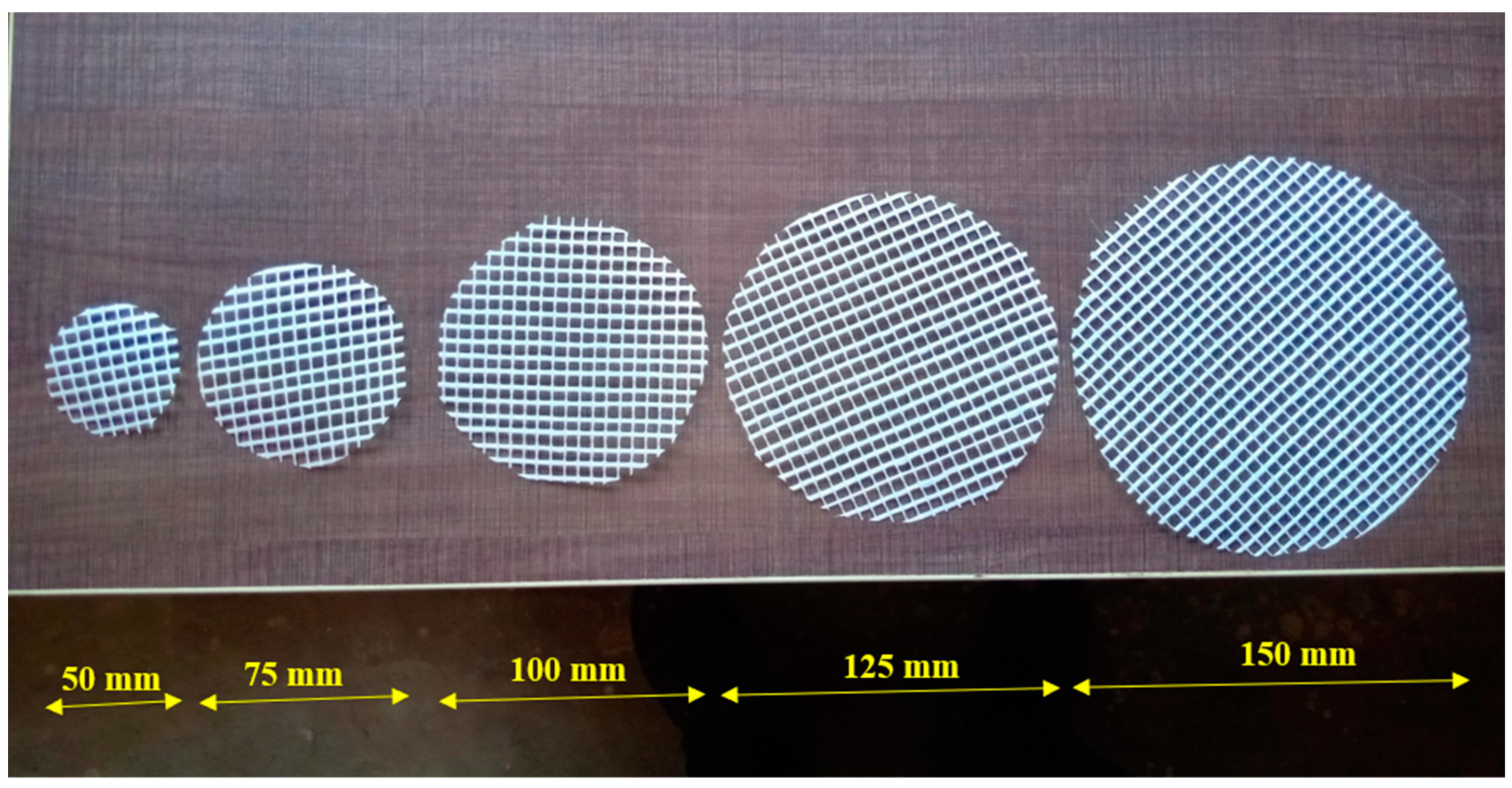

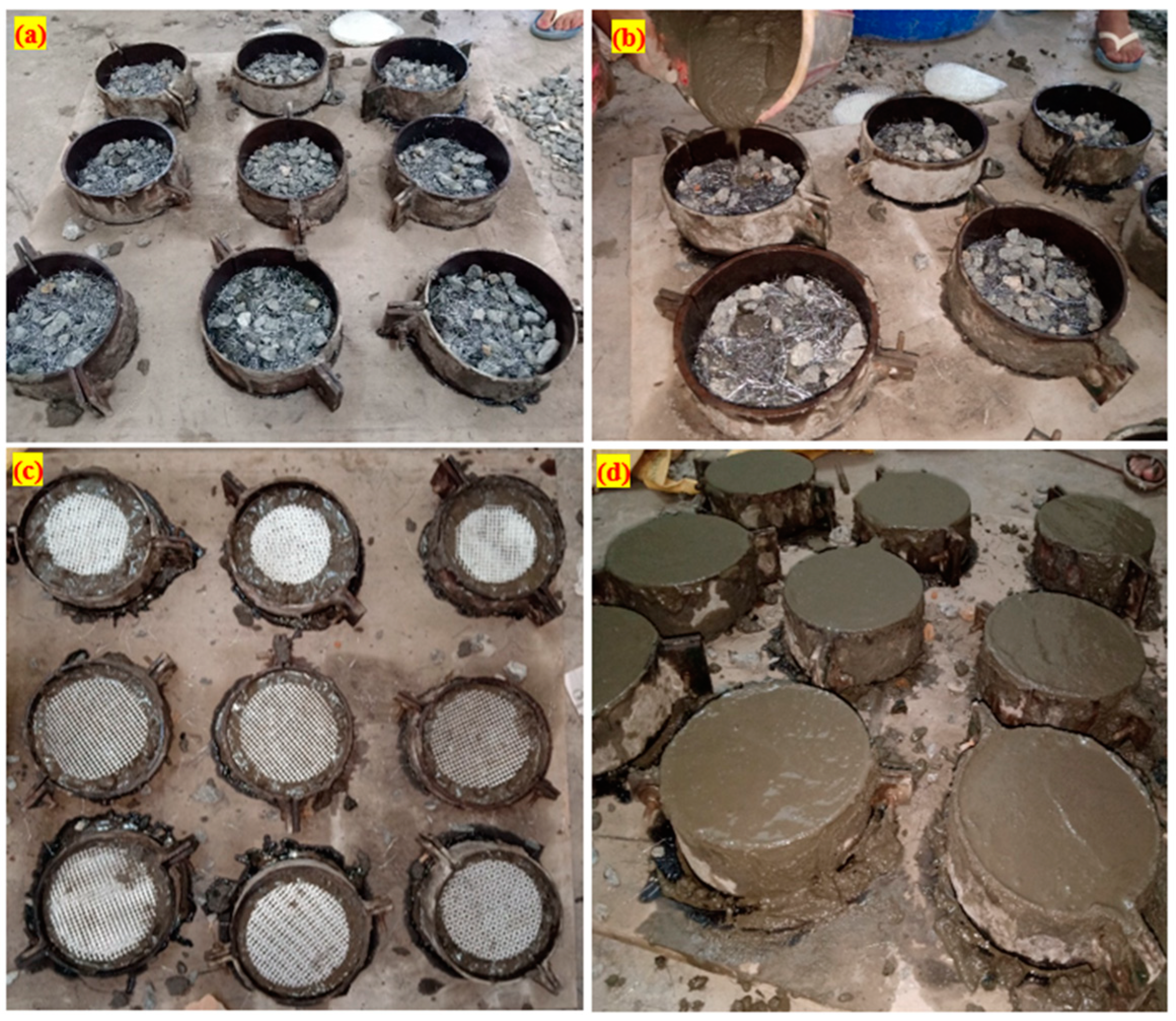
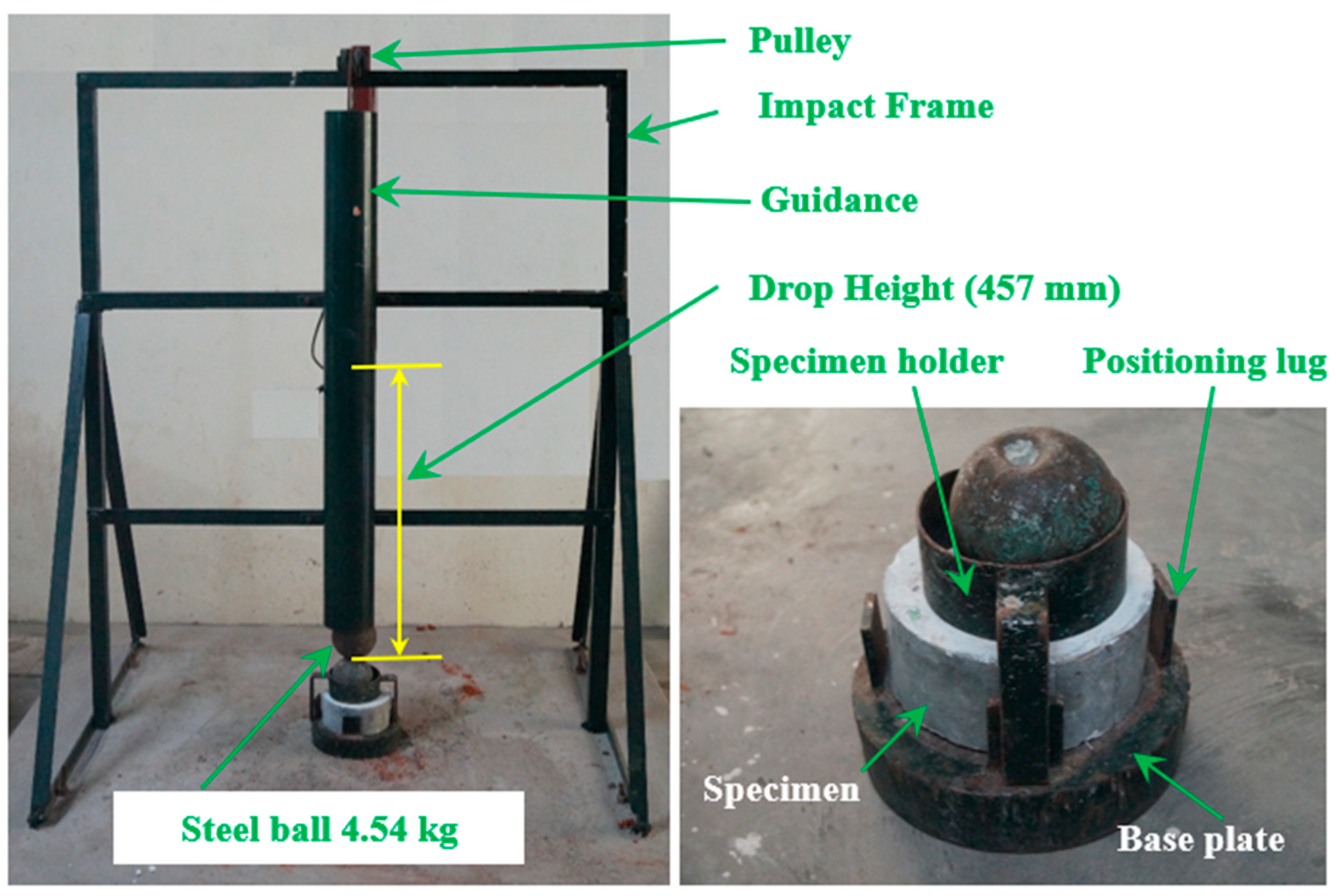
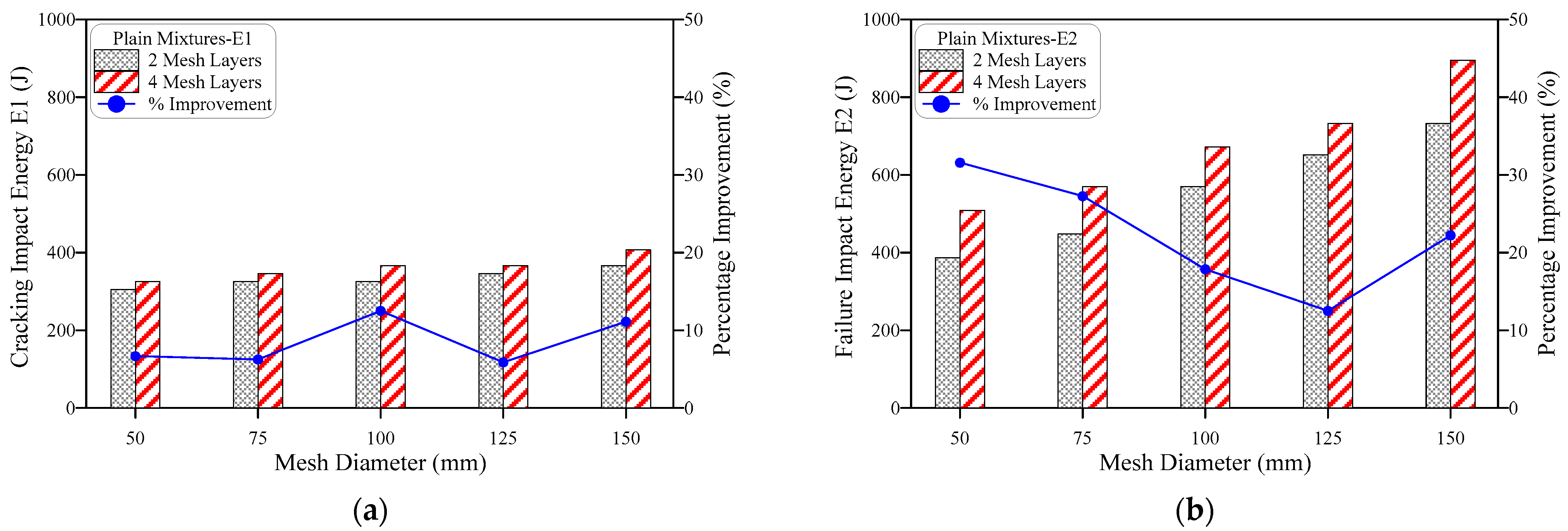
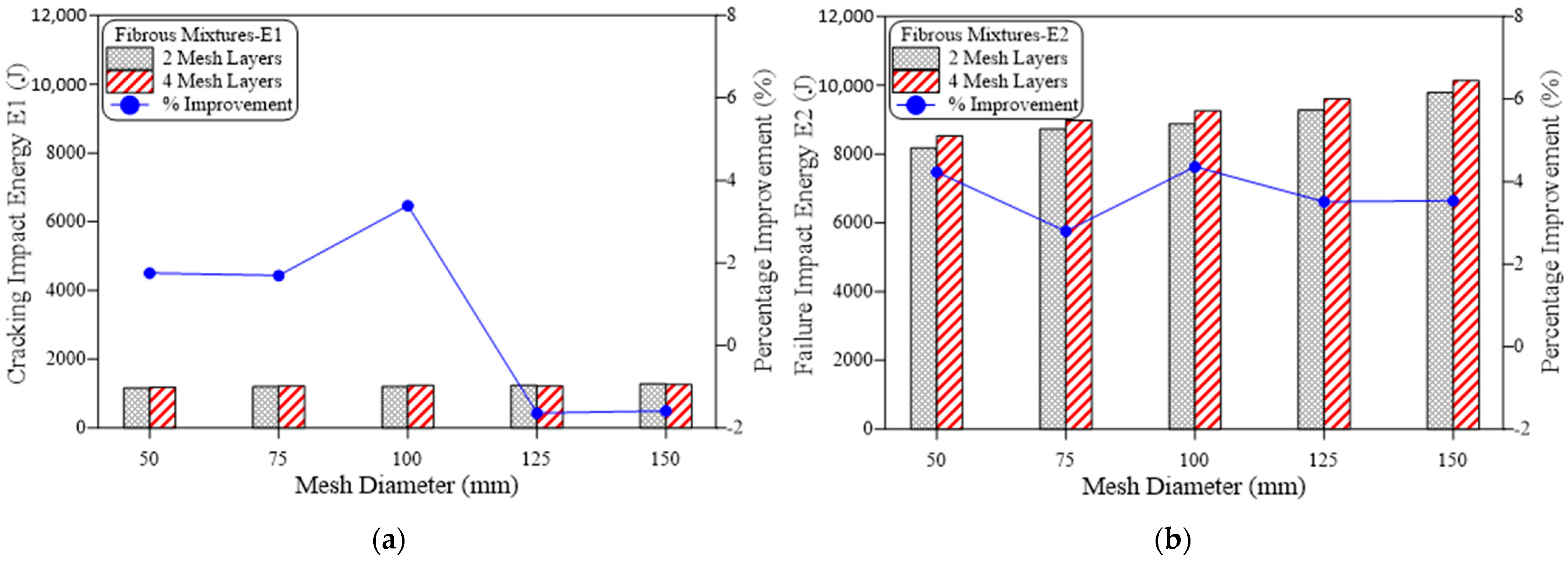
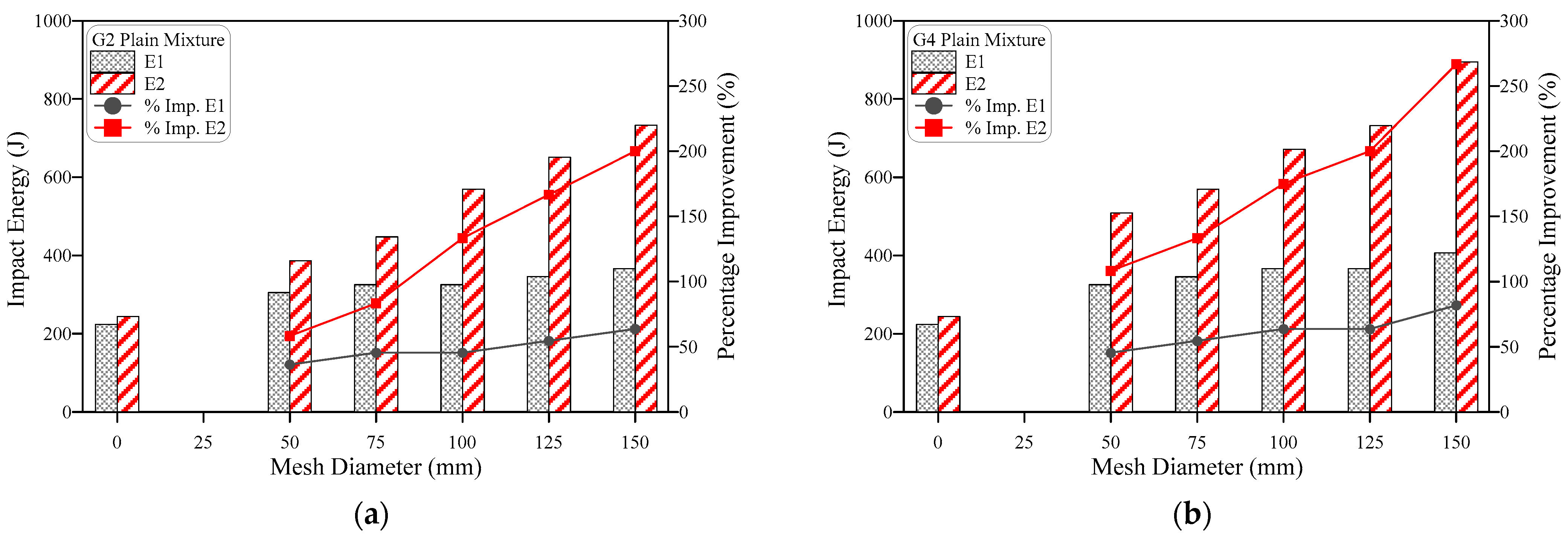
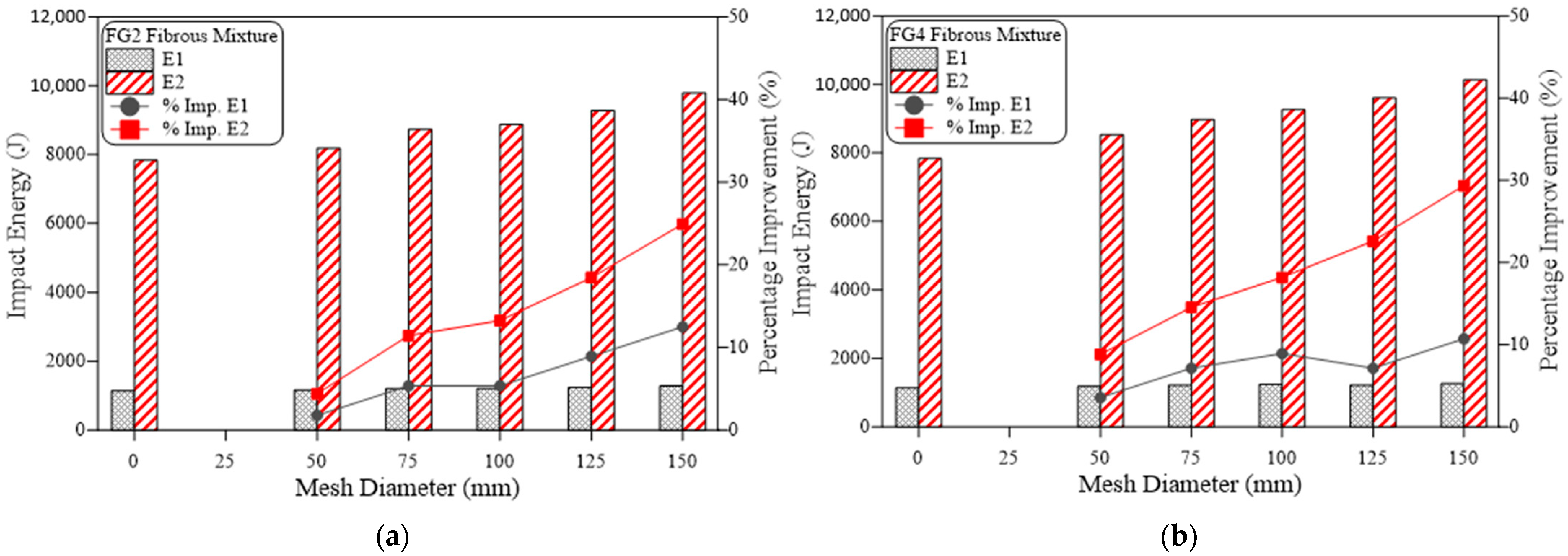
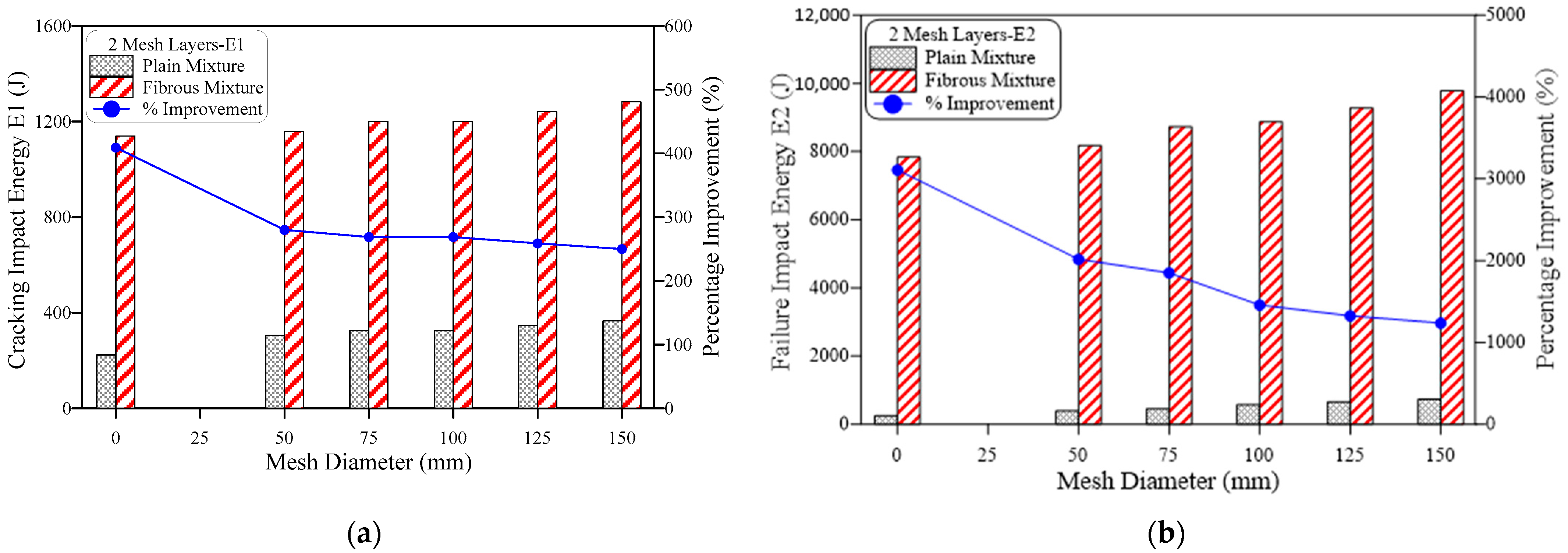
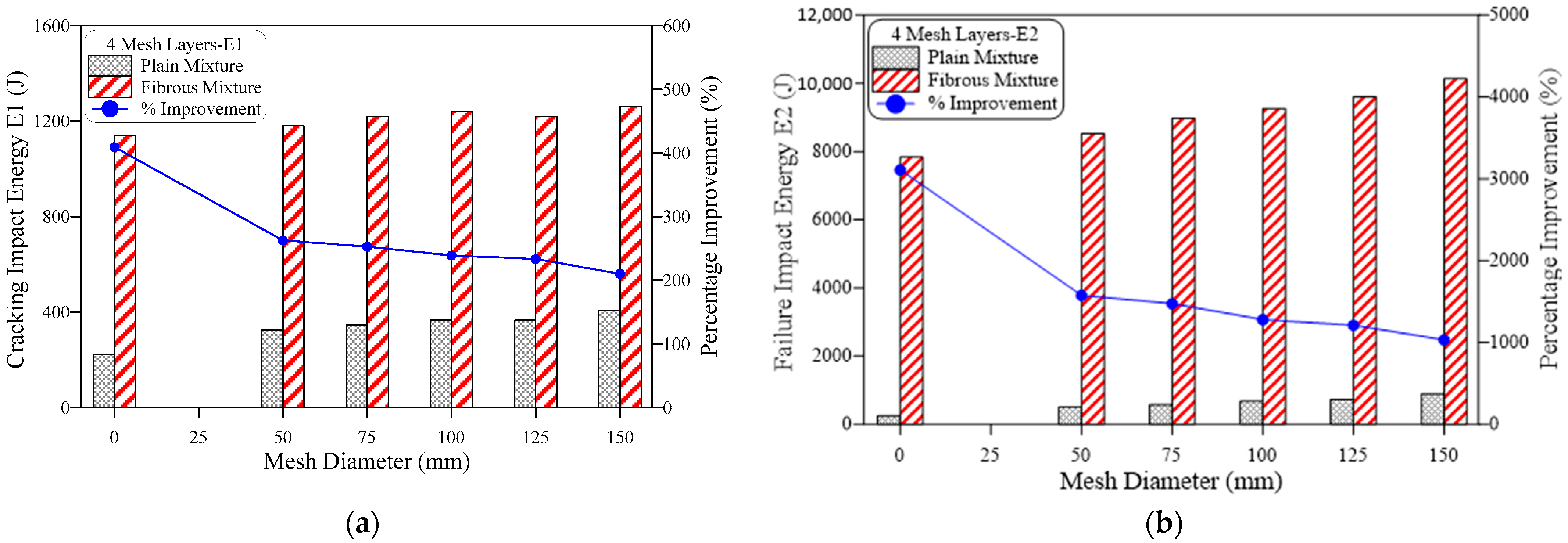
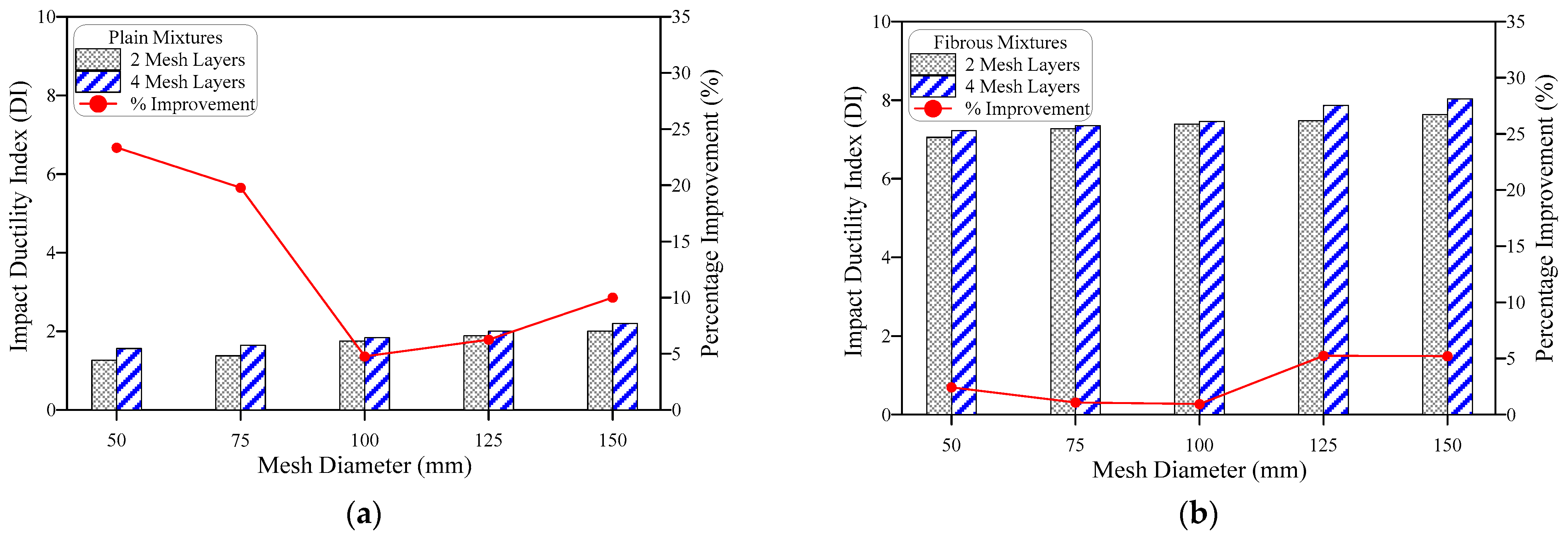

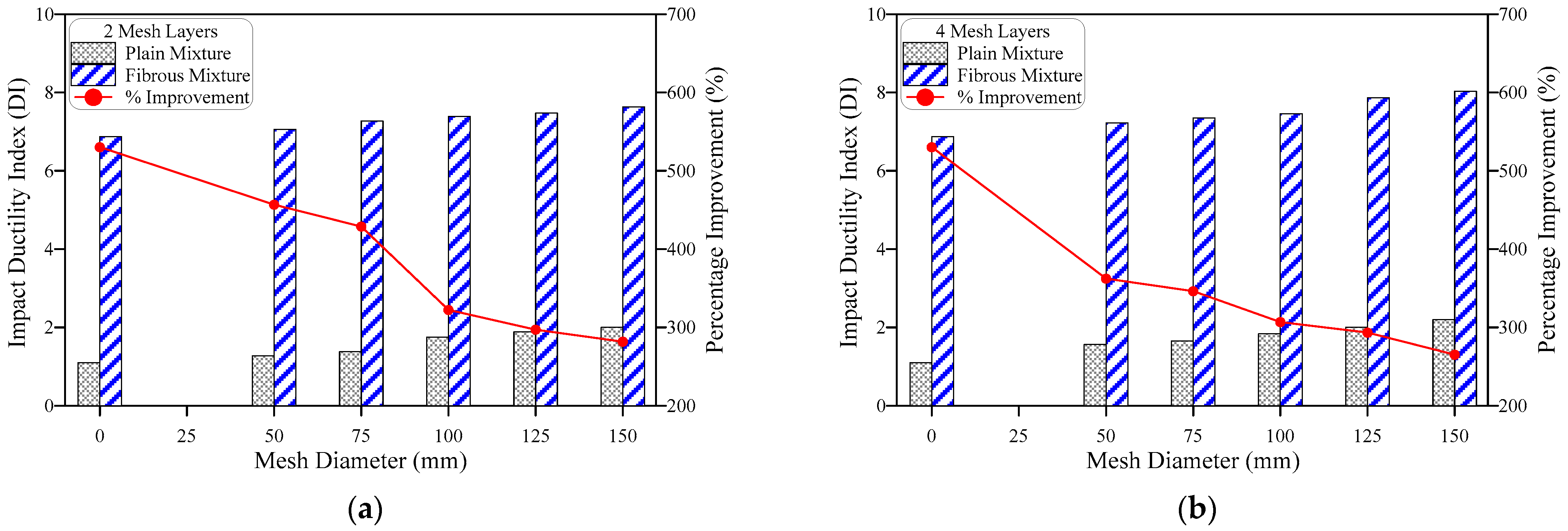



| Mixture Id | c/s | w/c | Diameter of GFM (mm) | Ratio of Reinforcement | Number of GFM Layer | Fiber Dosage (%) | SP (%) |
|---|---|---|---|---|---|---|---|
| CC | 1.0 | 0.45 | 0 | 0 | 0 | 0 | 0.4 |
| G2-50 | 1.0 | 0.45 | 50 | 0.33 | 2 | 0 | 0.4 |
| G2-75 | 1.0 | 0.45 | 75 | 0.5 | 2 | 0 | 0.4 |
| G2-100 | 1.0 | 0.45 | 100 | 0.67 | 2 | 0 | 0.4 |
| G2-125 | 1.0 | 0.45 | 125 | 0.83 | 2 | 0 | 0.4 |
| G2-150 | 1.0 | 0.45 | 150 | 1.0 | 2 | 0 | 0.4 |
| G4-50 | 1.0 | 0.45 | 50 | 0.33 | 4 | 0 | 0.4 |
| G4-75 | 1.0 | 0.45 | 75 | 0.5 | 4 | 0 | 0.4 |
| G4-100 | 1.0 | 0.45 | 100 | 0.67 | 4 | 0 | 0.4 |
| G4-125 | 1.0 | 0.45 | 125 | 0.83 | 4 | 0 | 0.4 |
| G4-150 | 1.0 | 0.45 | 150 | 1.0 | 4 | 0 | 0.4 |
| FC | 1.0 | 0.45 | 0 | 0 | 0 | 3 | 0.6 |
| FG2-50 | 1.0 | 0.45 | 50 | 0.33 | 2 | 3 | 0.6 |
| FG2-75 | 1.0 | 0.45 | 75 | 0.5 | 2 | 3 | 0.6 |
| FG2-100 | 1.0 | 0.45 | 100 | 0.67 | 2 | 3 | 0.6 |
| FG2-125 | 1.0 | 0.45 | 125 | 0.83 | 2 | 3 | 0.6 |
| FG2-150 | 1.0 | 0.45 | 150 | 1.0 | 2 | 3 | 0.6 |
| FG4-50 | 1.0 | 0.45 | 50 | 0.33 | 4 | 3 | 0.6 |
| FG4-75 | 1.0 | 0.45 | 75 | 0.5 | 4 | 3 | 0.6 |
| FG4-100 | 1.0 | 0.45 | 100 | 0.67 | 4 | 3 | 0.6 |
| FG4-125 | 1.0 | 0.45 | 125 | 0.83 | 4 | 3 | 0.6 |
| FG4-150 | 1.0 | 0.45 | 150 | 1.0 | 4 | 3 | 0.6 |
| Mix Id | Impact Numbers | Impact Energies (J) | Standard Deviation | Ductility Index (DI) | |||
|---|---|---|---|---|---|---|---|
| R1 | R2 | E1 | E2 | E1 | E2 | ||
| CC | 11 | 12 | 223.8 | 244.1 | 1.00 | 1.53 | 1.09 |
| G2-50 | 15 | 19 | 305.2 | 386.6 | 2.08 | 2.08 | 1.27 |
| G2-75 | 16 | 22 | 325.5 | 447.6 | 1.15 | 2.08 | 1.38 |
| G2-100 | 16 | 28 | 325.5 | 569.7 | 1.53 | 2.00 | 1.75 |
| G2-125 | 17 | 32 | 345.9 | 651.0 | 1.53 | 2.08 | 1.88 |
| G2-150 | 18 | 36 | 366.2 | 732.4 | 0.58 | 2.52 | 2.00 |
| G4-50 | 16 | 25 | 325.5 | 508.6 | 2.08 | 2.08 | 1.56 |
| G4-75 | 17 | 28 | 345.9 | 569.7 | 1.73 | 2.65 | 1.65 |
| G4-100 | 18 | 33 | 366.2 | 671.4 | 1.15 | 2.89 | 1.83 |
| G4-125 | 18 | 36 | 366.2 | 732.4 | 2.00 | 4.04 | 2.00 |
| G4-150 | 20 | 44 | 406.9 | 895.2 | 2.08 | 3.61 | 2.20 |
| FC | 56 | 385 | 1139.3 | 7832.8 | 3.79 | 4.36 | 6.88 |
| FG2-50 | 57 | 402 | 1159.7 | 8178.7 | 3.51 | 8.19 | 7.05 |
| FG2-75 | 59 | 429 | 1200.4 | 8728.0 | 3.06 | 9.02 | 7.27 |
| FG2-100 | 59 | 436 | 1200.4 | 8870.4 | 4.04 | 9.29 | 7.39 |
| FG2-125 | 61 | 456 | 1241.0 | 9277.3 | 3.06 | 4.58 | 7.48 |
| FG2-150 | 63 | 481 | 1281.7 | 9785.9 | 3.79 | 8.14 | 7.63 |
| FG4-50 | 58 | 419 | 1180.0 | 8524.6 | 3.51 | 8.50 | 7.22 |
| FG4-75 | 60 | 441 | 1220.7 | 8972.1 | 3.00 | 8.33 | 7.35 |
| FG4-100 | 61 | 455 | 1241.0 | 9257.0 | 2.65 | 6.00 | 7.46 |
| FG4-125 | 60 | 472 | 1220.7 | 9602.8 | 3.21 | 7.51 | 7.87 |
| FG4-150 | 62 | 498 | 1261.4 | 10,131.8 | 2.31 | 7.55 | 8.03 |
Publisher’s Note: MDPI stays neutral with regard to jurisdictional claims in published maps and institutional affiliations. |
© 2022 by the authors. Licensee MDPI, Basel, Switzerland. This article is an open access article distributed under the terms and conditions of the Creative Commons Attribution (CC BY) license (https://creativecommons.org/licenses/by/4.0/).
Share and Cite
Karthikeyan, M.; Verapathran, M.; Abid, S.R.; Murali, G. The Combined Effect of Glass Fiber Mesh and Steel Fiber on Two-Layered Preplaced Aggregate Concrete against Drop Weight Impact. Materials 2022, 15, 5648. https://doi.org/10.3390/ma15165648
Karthikeyan M, Verapathran M, Abid SR, Murali G. The Combined Effect of Glass Fiber Mesh and Steel Fiber on Two-Layered Preplaced Aggregate Concrete against Drop Weight Impact. Materials. 2022; 15(16):5648. https://doi.org/10.3390/ma15165648
Chicago/Turabian StyleKarthikeyan, Muniraj, Maruthasalam Verapathran, Sallal R. Abid, and Gunasekaran Murali. 2022. "The Combined Effect of Glass Fiber Mesh and Steel Fiber on Two-Layered Preplaced Aggregate Concrete against Drop Weight Impact" Materials 15, no. 16: 5648. https://doi.org/10.3390/ma15165648






